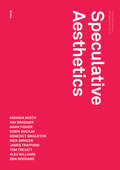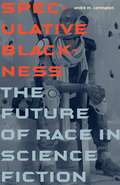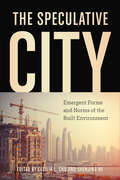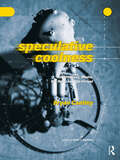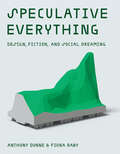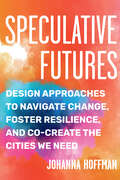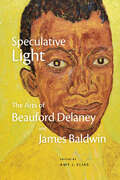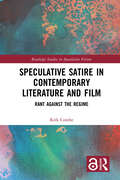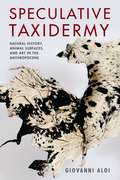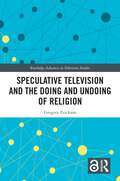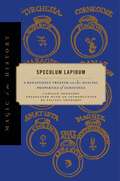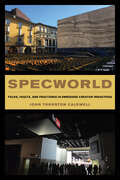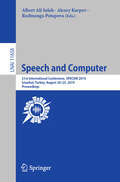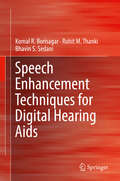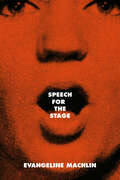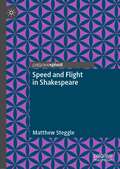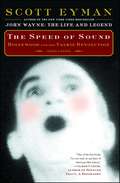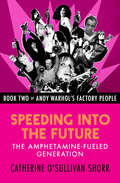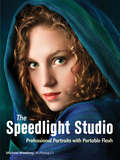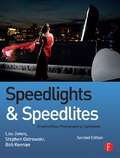- Table View
- List View
Speculative Aesthetics (Urbanomic / Redactions #4)
by Robin MackayAn examination of the new technological mediations between the human sensorium and the planetary media network and of the aesthetic as an enabler of new modes of knowledge.This series of interventions on the ramifications of Speculative Realism for aesthetics ranges from contemporary art's relation to the aesthetic, to accelerationism and abstraction, logic and design.From varied perspectives of philosophy, art, and design, participants examine the new technological mediations between the human sensorium and the massive planetary media network within which it now exists and consider how the aesthetic enables new modes of knowledge by processing sensory data through symbolic formalisms and technological devices.Speculative Aesthetics anticipates the possibility of a theory and practice no longer invested in the otherworldly promise of the aesthetic, but acknowledging the real force and traction of images in the world today, experimentally employing techniques of modelling, formalisation, and presentation so as to simultaneously engineer new domains of experience and map them through a reconfigured aesthetics that is inseparable from its sociotechnical conditions.
Speculative Blackness: The Future of Race in Science Fiction
by André M. CarringtonIn Speculative Blackness, André M. Carrington analyzes the highly racialized genre of speculative fiction—including science fiction, fantasy, and utopian works, along with their fan cultures—to illustrate the relationship between genre conventions in media and the meanings ascribed to blackness in the popular imagination.Carrington&’s argument about authorship, fandom, and race in a genre that has been both marginalized and celebrated offers a black perspective on iconic works of science fiction. He examines the career of actor Nichelle Nichols, who portrayed the character Uhura in the original Star Trek television series and later became a recruiter for NASA, and the spin-off series Star Trek: Deep Space Nine, set on a space station commanded by a black captain. He recovers a pivotal but overlooked moment in 1950s science fiction fandom in which readers and writers of fanzines confronted issues of race by dealing with a fictitious black fan writer and questioning the relevance of race to his ostensible contributions to the 'zines. Carrington mines the productions of Marvel comics and the black-owned comics publisher Milestone Media, particularly the representations of black sexuality in its flagship title, Icon. He also interrogates online fan fiction about black British women in Buffy the Vampire Slayer and the Harry Potter series. Throughout this nuanced analysis, Carrington theorizes the relationship between race and genre in cultural production, revealing new understandings of the significance of blackness in twentieth-century American literature and culture.
The Speculative City: Emergent Forms and Norms of the Built Environment
by Shenjing He Cecilia L. ChuThe Speculative City explores property speculation as a key aspect of financialization and its role in reshaping the contemporary built environment. The book offers a series of case studies that encompass a range of cities whose urban fabrics have undergone significant transformation in recent years. While the forms of these developments shared many similarities, their trajectories and social outcomes were contingent upon existing planning and policy frameworks and the historical roles assumed by the state and the private sector in housing and welfare provision. By paying close attention to the forces and actors involved in property development, this book underscores that the built environment has played an integral part in the shaping of new values and collective aspirations while facilitating the spread of financial logics in urban governance. It also shows that these dynamics represent a larger shift of politics and culture in the ongoing production of urban space and prompts reflections on future trajectories of finance-led property speculation.
The Speculative City: Art, Real Estate, and the Making of Global Los Angeles
by Susanna Phillips NewburyA forensic examination of the mutual relationship between art and real estate in a transforming Los Angeles Underlying every great city is a rich and vibrant culture that shapes the texture of life within. In The Speculative City, Susanna Phillips Newbury teases out how art and Los Angeles shaped one another&’s evolution. She compellingly articulates how together they transformed the Southland, establishing the foundation for its contemporary art infrastructure, and explains how artists came to influence Los Angeles&’s burgeoning definition as the global city of the twenty-first century.Pairing particular works of art with specific innovations in real estate development, The Speculative City reveals the connections between real estate and contemporary art as they constructed Los Angeles&’s present-day cityscape. From banal parking lots to Frank Gehry&’s designs for artists&’ studios and museums, Newbury examines pivotal interventions by artists and architects, city officials and cultural philanthropists, concluding with an examination of how, in the wake of the 2008 global credit crisis, contemporary art emerged as a financial asset to fuel private wealth and urban gentrification. Both a history of the transformation of the Southland and a forensic examination of works of art, The Speculative City is a rich complement to the California chronicles by such writers as Rebecca Solnit and Mike Davis.
Speculative Coolness: Architecture, Media, the Real, and the Virtual
by Bryan CantleyCantley’s work offers a unique and critical insight into the emergence of a liminal territory that exists between the real and the virtual that mainstream architecture has yet to exploit. Speculative Coolness surveys and collects a highly experimental architecture/design praxis. This book presents a selected body of his work, showcasing projects which seek to understand and explore the conditions, contexts, and media logics which govern this new territory, and to speculate on the Architecture[s] which it might occupy, and which might occupy it. Featuring both resolved projects and work[s] that are under development, this anthology represents constructs that locate themselves somewhere between architecture and its documentative media. The projects are presented alongside a series of critical essays written by pre-eminent architectural practitioners and theorists. These essays explore the disciplinary, social, and cultural context of the work, serving to underscore the importance of these explorations to the expansion of disciplinary knowledge.
Speculative Everything: Design, Fiction, and Social Dreaming
by Anthony Dunne Fiona RabyHow to use design as a tool to create not only things but ideas, to speculate about possible futures.Today designers often focus on making technology easy to use, sexy, and consumable. In Speculative Everything, Anthony Dunne and Fiona Raby propose a kind of design that is used as a tool to create not only things but ideas. For them, design is a means of speculating about how things could be—to imagine possible futures. This is not the usual sort of predicting or forecasting, spotting trends and extrapolating; these kinds of predictions have been proven wrong, again and again. Instead, Dunne and Raby pose “what if” questions that are intended to open debate and discussion about the kind of future people want (and do not want).Speculative Everything offers a tour through an emerging cultural landscape of design ideas, ideals, and approaches. Dunne and Raby cite examples from their own design and teaching and from other projects from fine art, design, architecture, cinema, and photography. They also draw on futurology, political theory, the philosophy of technology, and literary fiction. They show us, for example, ideas for a solar kitchen restaurant; a flypaper robotic clock; a menstruation machine; a cloud-seeding truck; a phantom-limb sensation recorder; and devices for food foraging that use the tools of synthetic biology. Dunne and Raby contend that if we speculate more—about everything—reality will become more malleable. The ideas freed by speculative design increase the odds of achieving desirable futures.
Speculative Futures: Design Approaches to Navigate Change, Foster Resilience, and Co-Create the Citie s We Need
by Johanna HoffmanHow the emerging field of speculative futures can help us dream--and build--better, sustainable, and more equitable cities for everyone.Speculative futures--design approaches that help us visualize new and potential worlds--move us beyond what currently exists into what could one day be. Inspired by art, film, fiction, and industrial design, they use speculation to provoke, imagine, and dream into what lies ahead.Written for futurists, urbanists, and artists looking to enact city-wide transformation--and for readers at the intersection of disruption, design, innovation, and city living--this book offers creative paths toward urban resilience, using design tools that already exist.Artist and urbanist Johanna Hoffman uses an interdisciplinary lens informed by her experience in architecture, art, engineering, and construction to examine how we can reimagine our cities at every level: as individuals, in community, and on a professional scale.Hoffman blends precedent studies, compelling research, and professional memoir, connecting urban development issues with the processes and actions best positioned to create better solutions for our cities. The result is a dynamic field guide that uses speculative futures to imagine, advocate for, and adapt to modern scales, scopes, and speeds of change.While this book is of great utility to professionals in the urban design and planning industries, it&’s also for people who resist received, capitalistic, technocratic ways of thinking--readers who seek new solutions to old problems with anti-colonial, living-systems-oriented lenses.
Speculative Light: The Arts of Beauford Delaney and James Baldwin
by Amy J EliasOver the course of a thirty-eight-year friendship, painter Beauford Delaney and writer James Baldwin shared their private lives and shaped one another’s artistic values. Speculative Light brings together scholars, critics, and artists who analyze the stylistic and historical import of Delaney's and Baldwin’s works and examine how this friendship fundamentally shaped the pair's ideas about art and life. The book’s contributors explore how the two men, sharing identities as queer Black American artists, first in New York and then as expatriates in France, created a speculative space in their work to think about more just and creative Black futures. Essay topics and issues range from masculinity, queerness, Blackness, and Americanness to the relationship between jazz, painting, and writing. Throughout, the contributors establish a positive history for Delaney's and Baldwin’s arts that refuses a subordinate role to white artists of the modernist avant-garde. Ultimately, Speculative Light demonstrates that Delaney and Baldwin's bond provides revolutionary grounds for theorizing contemporary Black art and life.Contributors. Hilton Als, Nicholas Boggs, Indie A. Choudhury, Shawn Anthony Christian, Rachel Cohen, Amy J. Elias, Monika Gehlawat, David Leeming, D. Quentin Miller, Fred Moten, Walton M. Muyumba, Robert O’Meally, Ed Pavlić, Levi Prombaum, Robert Reid-Pharr, Tyler T. Schmidt, Abbe Schriber, Jered Sprecher, Stephen C. Wicks, Magdalena Zaborowska
Speculative Satire in Contemporary Literature and Film: Rant Against the Regime (Routledge Studies in Speculative Fiction)
by Kirk CombeSince 1980, when neoliberal and neoconservative forces began their hostile takeover of western culture, a new type of political satire has emerged that works to unmask and deter those toxic doctrines. Literary and cultural critic Kirk Combe calls this new form of satire the Rant. The Rant is grim, highly imaginative, and complex in its blending of genres. It mixes facets of satire, science fiction, and monster tale to produce widely consumed spectacles—major studio movies, popular television/streaming series, bestselling novels—designed to disturb and to provoke. The Rant targets what Combe calls the Regime. Simply put, the Regime is the sum of the dangerous social, economic, and political orthodoxies spurred on by neoliberal and neoconservative polity. Such practices include free-market capitalism, corporatism, militarism, religiosity, imperialism, racism, patriarchy, and so on. In the Rant, then, we have a unique and wholly contemporary genre of political expression and protest: speculative satire.
Speculative Satire in Contemporary Literature and Film: Rant Against the Regime (Routledge Studies in Speculative Fiction)
by Kirk CombeSince 1980, when neoliberal and neoconservative forces began their hostile takeover of western culture, a new type of political satire has emerged that works to unmask and deter those toxic doctrines. Literary and cultural critic Kirk Combe calls this new form of satire the Rant. The Rant is grim, highly imaginative, and complex in its blending of genres. It mixes facets of satire, science fiction, and monster tale to produce widely consumed spectacles—major studio movies, popular television/streaming series, bestselling novels—designed to disturb and to provoke. The Rant targets what Combe calls the Regime. Simply put, the Regime is the sum of the dangerous social, economic, and political orthodoxies spurred on by neoliberal and neoconservative polity. Such practices include free-market capitalism, corporatism, militarism, religiosity, imperialism, racism, patriarchy, and so on. In the Rant, then, we have a unique and wholly contemporary genre of political expression and protest: speculative satire.
Speculative Taxidermy: Natural History, Animal Surfaces, and Art in the Anthropocene (Critical Life Studies)
by Giovanni AloiTaxidermy, once the province of natural history and dedicated to the pursuit of lifelike realism, has recently resurfaced in the world of contemporary art, culture, and interior design. In Speculative Taxidermy, Giovanni Aloi offers a comprehensive mapping of the discourses and practices that have enabled the emergence of taxidermy in contemporary art. Drawing on the speculative turn in philosophy and recovering past alternative histories of art and materiality from a biopolitical perspective, Aloi theorizes speculative taxidermy: a powerful interface that unlocks new ethical and political opportunities in human-animal relationships and speaks to how animal representation conveys the urgency of addressing climate change, capitalist exploitation, and mass extinction.A resolutely nonanthropocentric take on the materiality of one of the most controversial mediums in art, this approach relentlessly questions past and present ideas of human separation from the animal kingdom. It situates taxidermy as a powerful interface between humans and animals, rooted in a shared ontological and physical vulnerability. Carefully considering a select number of key examples including the work of Nandipha Mntambo, Maria Papadimitriou, Mark Dion, Berlinde De Bruyckere, Roni Horn, Oleg Kulik, Steve Bishop, Snæbjörnsdóttir/Wilson, and Cole Swanson, Speculative Taxidermy contextualizes the resilient presence of animal skin in the gallery space as a productive opportunity to rethink ethical and political stances in human-animal relationships.
Speculative Television and the Doing and Undoing of Religion (Routledge Advances in Television Studies)
by Gregory EricksonThis book explores the concept that, as participation in traditional religion declines, the complex and fantastical worlds of speculative television have become the place where theological questions and issues are negotiated, understood, and formed. From bodies, robots, and souls to purgatories and post-apocalyptic scenarios and new forms of digital scripture, the shows examined – from Buffy the Vampire Slayer to Westworld – invite their viewers and fans to engage with and imagine concepts traditionally reserved for religious spaces. Informed by recent trends in both fan studies and religious studies, and with an emphasis on practice as well as belief, the thematically focused narrative posits that it is through the intersections of these shows that we find the reframing and rethinking of religious ideas. This truly interdisciplinary work will resonate with scholars and upper-level students in the areas of religion, television studies, popular culture, fan studies, media studies, and philosophy.
Speculative Television and the Doing and Undoing of Religion (Routledge Advances in Television Studies)
by Gregory EricksonThis book explores the concept that, as participation in traditional religion declines, the complex and fantastical worlds of speculative television have become the place where theological questions and issues are negotiated, understood, and formed.From bodies, robots, and souls to purgatories and post-apocalyptic scenarios and new forms of digital scripture, the shows examined – from Buffy the Vampire Slayer to Westworld – invite their viewers and fans to engage with and imagine concepts traditionally reserved for religious spaces. Informed by recent trends in both fan studies and religious studies, and with an emphasis on practice as well as belief, the thematically focused narrative posits that it is through the intersections of these shows that we find the reframing and rethinking of religious ideas.This truly interdisciplinary work will resonate with scholars and upper-level students in the areas of religion, television studies, popular culture, fan studies, media studies, and philosophy.The Open Access version of this book, available at http://www.taylorfrancis.com, has been made available under a Creative Commons [Attribution-Non Commercial-No Derivatives (CC-BY-NC-ND)] 4.0 license.
Speculum Lapidum: A Renaissance Treatise on the Healing Properties of Gemstones (Magic in History)
by Camillo LeonardiIn early modern Europe precious and semiprecious stones were valued not only for their beauty and rarity but also for their medical and magical properties. Lorenzo de’ Medici, Philip II of Spain, and Popes Leo X and Clement VII were all treated with expensive potions incorporating ground gems such as rubies, diamonds, and emeralds. Medical and magical/astrological lapidaries, texts describing the stones’ occult and medical qualities as well as their abilities to ward off demons and incantations, were essential resources for their use. First published in Venice in 1502, Camillo Leonardi’s Speculum Lapidum is an encyclopedic summary of all classical and medieval sources of lithotherapy.In describing the natural, manifest, and occult properties of precious and semiprecious stones as well as their graven images and applications, the Speculum Lapidum provides tremendous insight into the role that medical astrology and astral magic played in the life of an Italian court in the early modern period. Liliana Leopardi’s English translation, complete with critical apparatuses, gives unprecedented access to this key text within the magical lapidary genre. A vital addition to the existing canon of lapidaria in translation, Leopardi’s work will be of special importance for students and scholars of the history of magic, medicine, religion, and Renaissance humanism, and it will fascinate anyone interested in the occult properties of precious and semiprecious stones.
Specworld: Folds, Faults, and Fractures in Embedded Creator Industries
by John Thornton CaldwellJohn Thornton Caldwell’s landmark Specworld demonstrates how twenty-first-century media industries monetize and industrialize creative labor at all levels of production. Through illuminating case studies and rich ethnography of colliding social-media and filmmaking practices, Caldwell takes readers into the world of production workshopping and trade mentoring to show media production as an untidy social construct rather than a unified, stable practice. This messy complex system, he argues, is full of discrete yet interconnected parts that include legacy production companies, marketers and influencers, aspirant online producers, data miners, financiers, talent agencies, and more. Caldwell peels away the layers of these embedded production systems to examine the folds, fault lines, and fractures that underlie a risky, high-pressure, and often exploitative industry. With insights on the ethical and human predicament faced by industry hopefuls and crossover creators seeking professional careers, Caldwell offers new interpretive frames and research methods that allow readers to better see the hidden and multifaceted financial logics and forms of labor embedded in contemporary media production industries.
Speech and Computer: 21st International Conference, SPECOM 2019, Istanbul, Turkey, August 20–25, 2019, Proceedings (Lecture Notes in Computer Science #11658)
by Albert Ali Salah Alexey Karpov Rodmonga PotapovaThis book constitutes the proceedings of the 21st International Conference on Speech and Computer, SPECOM 2019, held in Istanbul, Turkey, in August 2019.The 57 papers presented were carefully reviewed and selected from 86 submissions. The papers present current research in the area of computer speech processing including audio signal processing, automatic speech recognition, speaker recognition, computational paralinguistics, speech synthesis, sign language and multimodal processing, and speech and language resources.
Speech Enhancement Techniques for Digital Hearing Aids
by Komal R. Borisagar Rohit M. Thanki Bhavin S. SedaniThis book provides various speech enhancement algorithms for digital hearing aids. It covers information on noise signals extracted from silences of speech signal. The description of the algorithm used for this purpose is also provided. Different types of adaptive filters such as Least Mean Squares (LMS), Normalized LMS (NLMS) and Recursive Lease Squares (RLS) are described for noise reduction in the speech signals. Different types of noises are taken to generate noisy speech signals, and therefore information on various noises signals is provided. The comparative performance of various adaptive filters for noise reduction in speech signals is also described. In addition, the book provides a speech enhancement technique using adaptive filtering and necessary frequency strength enhancement using wavelet transform as per the requirement of audiogram for digital hearing aids.Presents speech enhancement techniques for improving performance of digital hearing aids;Covers various types of adaptive filters and their advantages and limitations;Provides a hybrid speech enhancement technique using wavelet transform and adaptive filters.
Speech for the Stage
by Evangeline MachlinFrom its original publication, thousands of actors have used this classic text to develop and refine their voice and speech. Evangeline Machlin includes warm-up routines for the voice but initially focuses on the importance of listening. She also discusses such important elements as relaxation, phonetics, articulation, resonance, pitch, rate of speech and stress. In addition, there are chapters on dialects, on reading aloud, sight reading, auditioning and performance.
Speed and Flight in Shakespeare
by Matthew SteggleShakespeare's plays are fascinated by the problems of speed and flight. They are repeatedly interested in humans, spirits, and objects that move very fast; become airborne; and in some cases even travel into space. In Speed and Flight in Shakespeare, the first study of any kind on the subject, Steggle looks at how Shakespeare’s language explores ideas of speed and flight, and what theatrical resources his plays use to represent these states. Shakespeare has, this book argues, an aesthetic of speed and flight. Featuring chapters on The Comedy of Errors, A Midsummer Night’s Dream, Romeo and Juliet, Henry V, Macbeth and The Tempest, this study opens up a new field around the ‘historical phenomenology’ of early modern speed.
The Speed of Sound: Hollywood and the Talkie Revolution 1926-1930
by Scott EymanFor the first time ever, here is the epic story of the transition from silent films to talkies - that moment when movies were totally transformed and the American public cemented its love affair with Hollywood. In the Speed of Sound, author Scott Eyman, whose biography of filmmaker Ernst Lubitsch was hailed as "resoundingly wonderful," has created a mixture of cultural and social history that is at once both scholarly and vastly entertaining. Here is the first and last. word on the missing chapter in the history of Hollywood, the ribbon of dreams by which America conquered the world. Myth has it that it happened overnight, that Al Jolson said a few words in The Jazz Singer and the talkies were born, that stars with weak or inappropriate voices either killed themselves or went into seclusion, that the movie industry simply refitted itself and went on with business. The truth, however, is more involved - not to mention sinister, colorful, and entertaining. Sound was something the industry had resisted, and it was accepted only reluctantly and only after the Warner Bros. Studio had forced the issue with its aggressive selling of The Jazz Singer. But that was 1927, and for a long time afterward there were still those filmmakers, film stars, and even some filmgoers who resisted the appealing novelty. Change, however, was inevitable, and when it came it was devastating. As Scott Eyman demonstrates in his fascinating account of this exciting era, it was a time when fortunes, careers, and lives were made and lost, when the American film industry came fully into its own, and when the American film-going public truly succumbed to Hollywood's bewitching spell.
Speeding into the Future: The Amphetamine-Fueled Generation (Andy Warhol's Factory People #2)
by Catherine O'Sullivan ShorrThe 2nd volume of an intimate oral history vividly, Speeding into the Future recounts how Andy Warhol and his superstars revolutionized both the art world and the nature of celebrity in the mid-1960s Spanning from 1965 through 1966, 2 years that could be considered the pinnacle of Andy Warhol's creative output, Speeding into the Future features firsthand accounts of life inside the Silver Factory. Powered by a steady supply of amphetamines, Quaaludes, and other drugs, the artists and misfits of the Factory crowd generated Warhol's controversial films and art while their own star-quotients rose and declined--and as they fell in and out of love with one another. During this period, Warhol created the notion of the "It Girl" by declaring debutante Edie Sedgwick the 1965 "Girl of the Year" and predicting her skyrocketing yet short-lived fame; he introduced German-born singer Nico to Lou Reed and John Cale of the Velvet Underground, hosting their rehearsals at the Factory; and codirected, with Paul Morrissey, his most commercially successful film, Chelsea Girls, featuring Nico, Brigid Berlin, Ondine, and other superstars. Speeding into the Future includes revelatory images snapped by Billy Name and other photographers as Bob Dylan visited the Factory, and goes behind the scenes of Warhol's films of Ondine, Ultra Violet, Taylor Mead, and Viva. In this powerful chronicle, Catherine O'Sullivan Shorr captures the events of these dizzying, outrageous years through the words of those who lived through them.
The Speedlight Studio
by Michael MowbrayIn this book, Michael Mowbray shows readers how to set up a completely speedlight-based portrait photography studio. He goes in depth regarding gear and techniques, providing photographers with scores of example portraits and lighting diagrams to make it easy to follow along and replicate the portrait lighting effects that he shows. Readers will learn about selecting speedlights (Mowbray covers Canon, Nikon, and third-party units), learning standard operations, and working with the units on the camera’s hot shoe (a connectivity device on top of the camera) or in the periphery for more flexible, controllable results. Readers will learn why modifying the light from speedlights will produce a lot more bang for their buck and will also discover a host of tools-commercial and DIY-that can be used to change the direction, color, and quality of light for the ultimate artistic control.
The Speedlight Studio
by Michael MowbrayIn this book, Michael Mowbray shows readers how to set up a completely speedlight-based portrait photography studio. He goes in depth regarding gear and techniques, providing photographers with scores of example portraits and lighting diagrams to make it easy to follow along and replicate the portrait lighting effects that he shows. Readers will learn about selecting speedlights (Mowbray covers Canon, Nikon, and third-party units), learning standard operations, and working with the units on the camera’s hot shoe (a connectivity device on top of the camera) or in the periphery for more flexible, controllable results. Readers will learn why modifying the light from speedlights will produce a lot more bang for their buck and will also discover a host of tools-commercial and DIY-that can be used to change the direction, color, and quality of light for the ultimate artistic control.
The Speedlight Studio
by Michael MowbrayIn this book, Michael Mowbray shows readers how to set up a completely speedlight-based portrait photography studio. He goes in depth regarding gear and techniques, providing photographers with scores of example portraits and lighting diagrams to make it easy to follow along and replicate the portrait lighting effects that he shows. Readers will learn about selecting speedlights (Mowbray covers Canon, Nikon, and third-party units), learning standard operations, and working with the units on the camera's hot shoe (a connectivity device on top of the camera) or in the periphery for more flexible, controllable results. Readers will learn why modifying the light from speedlights will produce a lot more bang for their buck and will also discover a host of tools-commercial and DIY-that can be used to change the direction, color, and quality of light for the ultimate artistic control.
Speedlights & Speedlites: Creative Flash Photography at the Speed of Light
by Lou JonesCanon Speedlites and Nikon Speedlights are small, off-camera flashguns that can provide big results - if you know how to use them properly. Acclaimed Boston photographers Lou Jones, Bob Keenan and Steve Ostrowski guide you through the technical and creative aspects of how to get the most out of these powerful tools in this indispensable guide, packed full of inspirational images and comprehensive diagrams of the lighting set ups used to capture them. They are significantly more advanced, lighter and considerably cheaper than a standard flashgun, and have many advantages. They are small (and cheap) enough that a number can be carried in your kit, and they can be used in combination, triggered wirelessly. They use through-the-lens (TTL) metering, which allows you to use the in-camera LCD and histograms to calculate the required power/direction, rather than havng to use a light meter or trial and error. They use proprietary, dedicated technology (from Canon and Nikon) that means there are no compatability issues. Getting the most out of them, however, remains a mystery - most photographers still just use their speedlights in the same way as a standard flash gun. This is where this book comes in.
